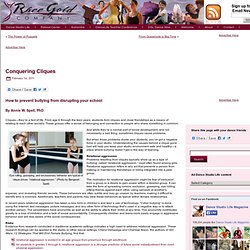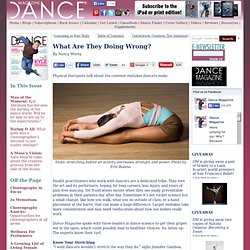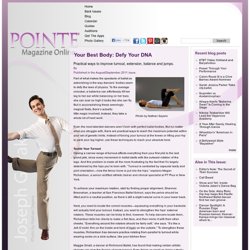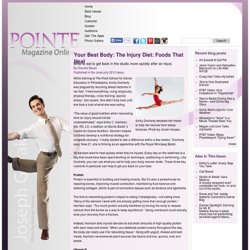

Dance Magazine – If it's happening in the world of dance, it's happening in Dance Magazine. By Nancy Wozny Physical therapists talk about the common mistakes dancers make. Static stretching before an activity decreases strength and power. Photo by Erin Baiano. Health practitioners who work with dancers are a dedicated tribe. They love the art and its performers, hoping for long careers, less injury, and years of pain-free dancing. Dance Magazine spoke with three leaders in dance science to get their gripes out in the open, which could possibly lead to healthier choices.
Know Your Stretching“I wish dancers wouldn’t stretch the way they do,” sighs Jennifer Gamboa, president of Body Dynamics, Inc., in Arlington, Virginia. Here’s the problem: According to recent studies, static stretching before an activity decreases strength and power. It’s not that static stretching is bad in and of itself, but it puts you at risk. Gamboa prefers dynamic stretching, which involves movement that is of low intensity and uses a broad range of motion.
Conquering Cliques. How to prevent bullying from disrupting your school By Annie W.

Spell, PhD Cliques—they’re a fact of life. From age 6 through the teen years, students form cliques and close friendships as a means of relating to each other socially. These groups offer a sense of belonging and connection to people who share something in common. Eye rolling, gossiping, and exclusionary behavior are typical of clique-driven “relational aggression.” Pointe magazine – Ballet at its Best. Practical ways to improve turnout, extension, balance and jumps.

Part of what makes the spectacle of ballet so astonishing is the way dancers’ bodies seem to defy the laws of physics. To the average onlooker, a ballerina can effortlessly lift her leg to her ear while balancing on her toes; she can soar so high it looks like she can fly. But in accomplishing these seemingly magical feats, there’s actually little magic involved.
Instead, they take a whole lot of hard work. Even the most talented dancers aren’t born with perfect ballet bodies. Tackle Your TurnoutHaving a narrow range of turnout affects everything from your first plié to the last grand jeté, since every movement in ballet starts with the outward rotation of the legs. To achieve your maximum rotation, start by finding proper alignment. Next, you need to locate the correct muscles—squeezing everything in your backside will actually limit your turnout. Boost Your BalanceTrying to build up your balance? Dance Studio Life. Madame Peff’s distinctive approach to training dancers and teachers By Maureen Janson When Madame Peff Modelski teaches ballet class, everyone in the studio experiences a dynamic fusion of knowledge, professionalism, and love of the art form.

Combining wit and intelligence, Modelski has developed a thorough approach to teaching and coaching that has captivated adult dancers for the past 35 years. After a lengthy performing career that included dancing with American Ballet Theatre and Metropolitan Opera Ballet and in several Broadway shows, Modelski taught daily advanced classes at Steps on Broadway in New York City for more than 25 years.
And she continues to teach and coach professionals in her unique way. Dance Magazine – If it's happening in the world of dance, it's happening in Dance Magazine. By Nancy Wozny Physical therapists talk about the common mistakes dancers make.

Pointe magazine – Ballet at its Best. I generally break my pointe shoes quickly, and some of the people at my studio glue theirs to make them last longer.

Does this really work? If so, where should I glue them exactly? —Juliae Yes! Pointe magazine – Ballet at its Best. The word’s meaning proves as debatable as who is—or isn’t—one.

The word “ballerina,” according to the Oxford English Dictionary, originated in the late 1700s and was the feminine of ballerino, Italian for “dancing master,” which descended from the Latin ballare, “to dance.” More recent definitions include Merriam-Webster’s “a woman who is a ballet dancer” and American Heritage’s “a principal woman dancer in a ballet company.” Pointe magazine – Ballet at its Best. Practical ways to improve turnout, extension, balance and jumps.

Part of what makes the spectacle of ballet so astonishing is the way dancers’ bodies seem to defy the laws of physics. To the average onlooker, a ballerina can effortlessly lift her leg to her ear while balancing on her toes; she can soar so high it looks like she can fly. But in accomplishing these seemingly magical feats, there’s actually little magic involved. Instead, they take a whole lot of hard work. Even the most talented dancers aren’t born with perfect ballet bodies. Pointe magazine – Ballet at its Best. Sally Turkel never had a problem with her feet.

Tape on her big and little toes was all she needed before slipping on her pointe shoes. But when she joined Colorado Ballet, the new demands of company life took a toll, and blisters became a constant enemy. Six Dance Bag Must-Haves + Delayed Onset Muscle Soreness. Megan Fairchild in George Balanchine’s Theme and Variations (by Paul Kolnik) Six Dance Bag Must-Haves Whether you’re spending your summer competing at Nationals, taking classes at your studio or training at an intensive, it’s important to make sure nothing stops you from dancing your best. Muscle cramps, blisters and even jittery nerves can all be alleviated—if you’re prepared! We caught up with New York City Ballet principal Megan Fairchild to find out the dance bag items that keep her on her A-game. 1. Dance Magazine – If it's happening in the world of dance, it's happening in Dance Magazine. The next time you near the end of a ridiculously tough combination and your legs feel like they can't possibly jump one more time, start talking to yourself—it could help you find energy your muscles didn't know they had.
Physical fatigue is still largely a mystery to scientists, and we are just beginning to learn how big of a role the mind plays in the equation. For a recent study published in the journal Medicine & Science in Sports & Exercise, researchers asked active young men and women to bike to the point of limp exhaustion multiple times. They found that when the riders told themselves things like "Feeling good" aloud or in their heads, they were able to pedal for longer and with greater ease, even though their exertion remained the same. It seems that a certain amount physical exhaustion is all in our heads. Some speculate that this is our brain's way of protecting the body from overexerting itself. Modern Essentials. Want to land a spot with Gallim Dance or Alonzo King LINES Ballet? You’d better head to modern class. But if you’re new to the style, don’t freak out! Just as ballet relies on a specific vocabulary, much of modern choreography also stems from a group of fundamental movements.
DS spoke with master teachers to give you a leg up on three that are at the heart of the style. THE CONTRACTIONOrigins: Always partnered with a release, the contraction is the core of Martha Graham’s technique.Who uses it today: The Martha Graham Dance Company, and choreographers including Ohad Naharin, Paul Taylor, Mark Dendy and Pascal Rioult. Dance Magazine – If it's happening in the world of dance, it's happening in Dance Magazine. Dance Magazine – If it's happening in the world of dance, it's happening in Dance Magazine.
By Lauren Kay The shoulders are one of a dancer’s most useful expressive tools.

Just think of a well-placed épaulement: An open chest and thoughtfully angled shoulders can exude confidence, playfulness, or power. But rolling the shoulders forward or pinching the scapulae together can read as just the opposite—timid, tentative, or tense. For advice on working through these tendencies and improving shoulder alignment, DM spoke with yoga practitioner, ballet teacher, and former Royal Ballet soloist Hilary Cartwright; master jazz teacher Patti Wilcox; and Alexander Technique expert Jane Kosminsky. Habit: Rolling the shoulders forward. Pointe magazine – Ballet at its Best. While training at The Rock School for Dance Education in Philadelphia, Emily Docherty was plagued by recurring stress fractures in her feet.

“I tried everything—icing religiously, physical therapy, cross-training, special shoes,” she recalls. Pointe magazine – Ballet at its Best. What to wear if you’re busty, plus tips on dealing with uneven hips and crafting your career path Have a question? Click here to send it to Suzanne Farrell Ballet dancer Amy Brandt. I am very self-conscious about my breast size, to the point where I always wear a T-shirt over my leotard. All the other girls at my studio are flat-chested. Any advice?